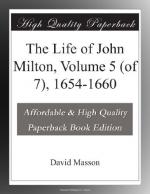[Footnote 1: Baillie, ut supra; Life of Robert Blair, 313 et seq.; Wodrow’s Introduction to his History (1721); Beattie’s Church of Scotland during the Commonwealth (1842), Chap. III.]
Though the Protesters were originally what we have called super-ultra-Presbyterians, it was not surprising that some of them had moved into Independency. There certainly were some Independents among the Scottish parish clergy at this time, especially about Aberdeen; and the Independents apart from the National Church had become numerous. But mere Independency now, or even Anabaptism, was nothing very shocking in Scotland; it was the increase of newer sectaries that alarmed the clergy. Quakerism had found its way into Scotland; so that there were now, we are told by a contemporary, “great numbers of that damnable sect of the Quakers, who, being deluded by Satan, drew away many to their profession, both men and women.” As in England, Quaker preachers went about disturbing the regular service in churches, or denouncing every form of ministry but their own to open-air congregations, and often with physical convulsions and fits of insane phrenzy. The Church-courts and the civil authorities were much exercised by the innovation, and had begun action against the sect, the rather because many of the common people, in their weariness of the strife among their own clergy, “resetted” the Quaker preachers and said they “got as much good of them as of anybody else."[1]
[Footnote 1: The quotations are from Chambers’s Dom. Annals of Scotland, II. 232-234.]
Not an importation like Quakerism, but of ineradicable native growth, was the crime of witchcraft; and, though that crime was known in England too, and occupied English law-courts, Scotland maintained her fearful superiority in witch-trials and witch-burnings. “There is much witchery up and down our land,” wrote Baillie: “the English be but too sparing to try it, but some they execute.” Against crimes of other orders the English judges were willing enough to act; and nothing is more startling to one who is new to such facts than to find how much of their business, in pious and Presbyterian Scotland, consisted in trials of cases of hideous and abnormal sexualism. But, indeed, very strange isms of quite another sort, and of which mere modern theory would have pronounced the Scotland of that time incapable, lurked underneath all the piety, all the preaching, all the exercise of Presbyterian discipline, all the seeming distribution of the population universally into Resolutioners and Protesters, with interspersed Independents, Baptists, Quakers, and other vehement Christians. Bead, from the Scottish correspondence of Needham’s Mercurius Politicus, in the number for June 26-July 3, 1656, the following account of one of the cases that had come before Judge Smith and Judge Lawrence in their Dumfriesshire circuit of the previous May:—




